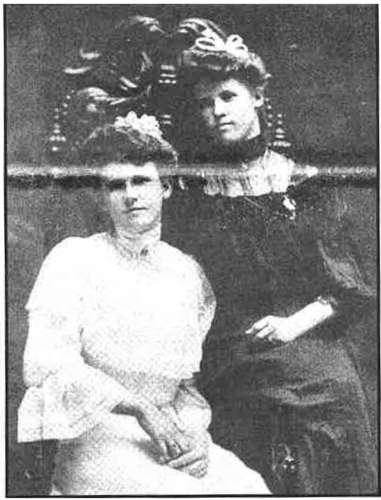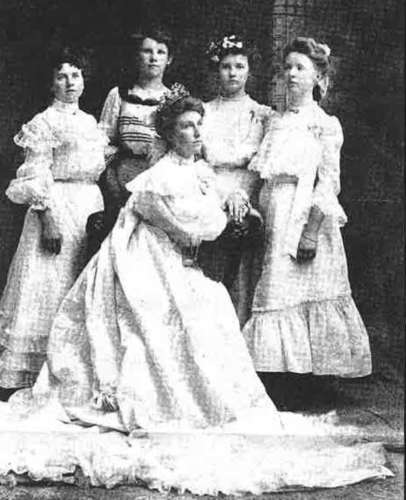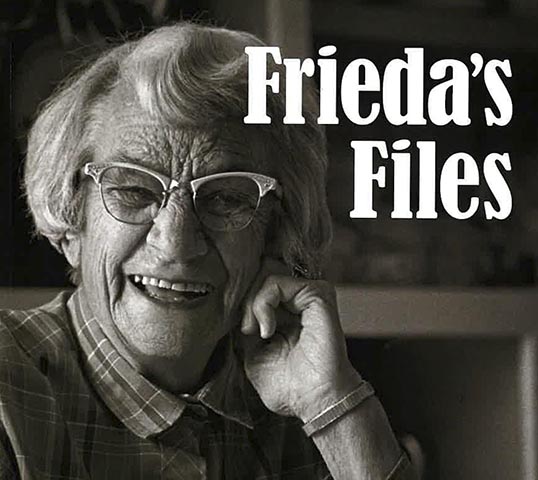Frieda’s Files are a collection of historical short stories about Carson Valley by Frieda Cordes Godecke, published in The Record-Courier. Reproduced here with permission from the Cordes Cousins, and their book “Frieda’s Files”.
November 9, 1978: Fashion and frills, bloomers and bows
Mama gathered her long skirts about her, put her foot on the step behind the wheel, and swung herself into the front seat of the springwagon. Papa held the reins, and their brood was already lined up on the backseat. It was a beautiful Sunday morning in the summer of 1908.
Mama looked like the lady on the cover of Weinstein-Lubin’s catalogue from whence the lovely yellow straw hat trimmed with beautiful pink roses and pink bows had come. The hat was held in place by two jeweled hat pins poked through the crown of her hat and the knot of hair on the top of her head.
It took some doing for a lady to be dressed for church. It began with the uncomfortable, stiff garment known as a corset. Drawstrings in back cinched at the waistline to such an extent that even breathing was a difficult matter. It was hooked in front, and steel stays kept it in shape. Over it was worn a lace trimmed corset cover, long bloomer type pants edged with crochet lace, and one or two starched petticoats.

Pretty Girls
Two young ladies dressed in the height of fashion about 1898 – Miss Jeannie Jacobsen and Miss Minnie Jacobsen – Sisters of Lillian Logan
Then came the outer garment – either a ruffled dress or a full dark skirt and a long sleeved blouse. Sometimes a black velvet band was worn around the throat, and when a blouse was fashioned with a high neck, small stays kept it in place. It took some time to hook the 12 to 14 buttons on her high shoes. The buttonhook used in those days is now a collector’s item. A lace handkerchief was tucked in her belt or peeked from her beaded bag. A gold watch was pinned to the yoke of her blouse. Her coat was usually very plain, and in cold weather she carried a silk-lined fur muff to keep her hands warm. On a hot day she held a dainty little parasol to protect her from the sun.
A lady never went to church without being properly dressed in hat, gloves, and long sleeve dress or blouse. She took her place together with her children on the lady’s side of the aisle, and her husband sat with the other men on the opposite side. It was a must for him to wear a coat or jacket and a white shirt with stiff collar which was held in place with collar buttons. For that matter, a man never thought to enter a bank or the courthouse in his shirt sleeves either.
There were no beauty salons in Carson Valley in the early 1900s. When milady wished to look especially beautiful, she worked miracles with a curling iron heated over the flame of a kerosene lamp or by twisting her trusses around small leather curlers. Most beauty aids of today were unheard of, so when a lady’s cheeks or lips were rosy it was usually her good health shining through.
Styles change drastically and sometimes very rapidly. The freedom of the wide, full skirt gave way to the very opposite style – the hobble skirt. Skirts were still long, but so little material was used in the making that a lady was forced to take very short steps. Among other things she found it very difficult to climb in and out of a wagon or an early day car. The problem was solved somewhat when the two side seams were left open at the hem for six or eight inches. This skirt was called a slit skirt.

July 4th Queen
Miss Hannah Harris was chosen queen of a Fourth of July celebration shortly before the turn of the century. With queen Hannah are her attendants – Georgia Nelson, Jenny Jacobsen, Emma Larson and Vadrie Swall. Photo courtesy of Lillian Logan
Styles changed again around ‘15 or ‘16 when street clothes were worn several inches below the knee. At the end of World War I in 1918, some of the more daring young ladies were wearing fancy knee-high hosiery with colored, straight stretch tops to match their costumes. These were the years, too, when the “Castle Bob” made famous by the dancer Irene Castle became popular. Older folk frowned on the idea, but it wasn’t long before they also saw the convenience of having short hair. The cut-off hair was made into a ‘switch’ just in case you were unhappy with the bob.
Next came the roaring ‘20s and the flapper age. Girdles took the place of corsets, waistlines disappeared, and skirts were knee length. Sleeveless dresses and high heels were the rage.
Sports were popular to a certain extent among the younger women in the early years of 1900. When a lady went for a horseback ride, she wore a divided skirt made of khaki or corduroy. No one thought of wearing pants in those days. When she went for a dip in the swimming pool at Walley Hot Springs, she felt she looked right in a one-piece bathing suit with short puffed sleeves and square collar. Long black stockings were tucked into full plaited pants that extended below the knee. Girls playing basketball at Douglas High wore full, black serge bloomers that covered the knees. With these were worn white middy blouses and handmade mesh caps made of orange crochet cotton.
It wasn’t always as easy for a lady to pick up a new spring outfit or a fall coat as it is today. Her chief sources to replenish her wardrobe were the catalogs of Bellas Hess, Weinstock Lubin, and Sears Roebuck. From their pages she chose wearing apparel for herself and her family. What a joy it was to receive such a package in the mail and “ooh” and “ah” over its contents!
Then there was Mrs. Rajah. She drove about the valley with her little black horse and backboard and her beautiful assortment of the latest fashions in hats trimmed with feathers, flowers, ribbons, and bows. Her daughter, Mrs. Sorrensen, operated a millinery shop in Gardnerville. A lady always felt well dressed when she wore one of Mrs. Rajah’s hats.
The old foot operated Singer or White sewing machine came in for much help in a large family. A mother not only created fashions for herself but kept her children looking neat and well dressed also. Sometimes a seamstress, either at her own home or living in with a family for a week or two, was engaged to make garments for the entire family. Dresses, boy’s shirts, curtains, and various other items often came from the same bolt of calico or gingham. Nightclothes, undergarments, and diapers all came from the same bolt of flannelette.
From bustles to leg-o-mutton sleeves to hobble skirts, from flapper dresses to mini skirts, we are today enjoying the freedom and comfort of pantyhose, sensible dresses, and slack suits. And we are finding it very pleasant indeed!



